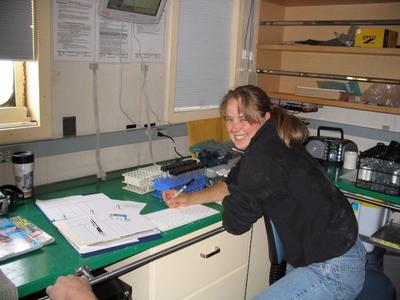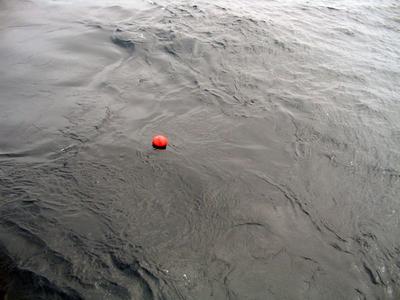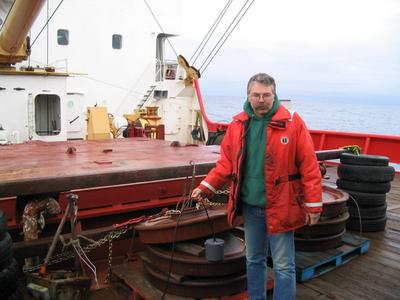17 July, 2004
I'm writing this on the 16th since we start our next set of stations at 2:30
tomorrow morning. These stations will be very close together so we will
barely get the work done for one before the next one starts.
Bill Floering and Sarah Thornton are both working on moorings this cruise.
Additionally, I'm lucky enough to have Sarah as my roommate. She doesn't
mind when I'm up at odd hours, and today she even let me sleep while she
folded my laundry! Sarah is from Vancouver, B.C., but she's been at the
University of Alaska Fairbanks for nine years. In her current job of
research technician she averages six-seven research cruises each year. Bill
is a field operations scientist with NOAA (National Oceanic and Atmospheric
Administration) and PMEL (Pacific Marine Environmental Lab) based in
Seattle, Washington. Together, Sarah and Bill deployed three moorings on
this cruise and attempted to retrieve one other.
Bill's instruments on the moorings are designed to look at the nutrient rich
water coming onto and circulating throughout the shelf (the shallow ocean
floor off the coast). The first two moorings contained all NOAA instruments
including those to read salinity and temperature as well as a fluorometer
for chlorophyll and an ADCP (Acoustic Doppler Current Profiler). The sound
signal from the ADCP is sent up and returned as it pings off plankton in the
water giving readings which translate into speed and direction of the
current. Bill will coordinate all the readings with the information
gathered from the CTD water sampling done both before and after the moorings
deployment. All in all, the data will provide information about the
physical properties and some biological properties of the water column.
Following the deployment of the first two moorings, Bill deployed a drifter
off the aft deck. The basketball-sized drifter is stabilized by a drouge
(see the picture) and will send signals to satellites thus getting a
position reading every six hours over a period of nine months to a year.
Check the picture of the drouge as it goes into the water and before it
sinks. Living on Lake Champlain in Vermont, I have often heard stories of
Champ, the lake monster. Anyone seeing this drouge in the fog and mist
would be convinced Champ had come to the Bering Sea!
The last mooring deployed had NOAA instruments plus one from the University
of Alaska Fairbanks that Sarah was overseeing. The instrument lies
approximately 18 meters below the surface and measures dissolved nitrate, an
important nutrient for the phytoplankton in the water. At 18 meters, the
instrument is in the euphotic (eu - true, photic - refers to light) where
light penetrates and is accessible to the phytoplankton. The "lost" mooring
(remember that they hope to find it in the fall) had a similar set of
instruments. Had we been able to retrieve the mooring, Sarah would have
downloaded a year's worth of data immediately. As Sarah said, scientists
use moorings because "they can be here when we are not." All the testing
done from the ship is a snapshot of a single site on one day, but the
mooring gives us a longer term data set.
Note: We are now coming up to our fourth station on this line, and it's
11:15 AM. Individual days and times really run together, especially when it
is light most of the time and one is getting very little sleep.

Sarah Thornton, research technician and my roommate. --

In this picture of the mooring anchor, Sarah is the one in the green hard hat. --

This basketball shaped buoy will send its position to satellites so scientists can see where this body of water is drifting over a 9-12 month period. --

Bill Floering is a field operations scientist with NOAA and PMEL (check journal for definitions). --

The drouge, which sinks and stabilizes the buoy, could easily be mistaken for a sea monster if seen in the fog! --
Contact the TEA in the field at
.
If you cannot connect through your browser, copy the
TEA's e-mail address in the "To:" line of
your favorite e-mail package.
|
